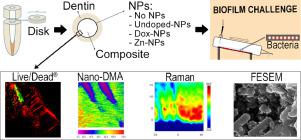Acta Biomaterialia ( IF 9.4 ) Pub Date : 2020-05-19 , DOI: 10.1016/j.actbio.2020.05.002 Manuel Toledano-Osorio 1 , Raquel Osorio 1 , Fátima S Aguilera 1 , Antonio Luis Medina-Castillo 2 , Manuel Toledano 1 , Estrella Osorio 1 , Sergio Acosta 3 , Ruoqiong Chen 4 , Conrado Aparicio 5

|
The objective was to assess doxycycline (Dox) and zinc (Zn) doped nanoparticles' (NPs) potential to protect the resin-dentin interface from cariogenic biofilm. Three groups of polymeric NPs were tested: unloaded, loaded with zinc and with doxycycline. NPs were applied after dentin etching. The disks were exposed to a cariogenic biofilm challenge in a Drip-Flow Reactor during 72 h and 7 d. Half of the specimens were not subjected to biofilm formation but stored 72 h and 7 d. LIVE/DEAD® viability assay, nano-dynamic mechanical assessment, Raman spectroscopy and field emission electron microscopy (FESEM) analysis were performed. The measured bacterial death rates, at 7 d were 46% for the control group, 51% for the undoped-NPs, 32% for Dox-NPs, and 87% for Zn-NPs; being total detected bacteria reduced five times in the Dox-NPs group. Zn-NPs treated samples reached, in general, the highest complex modulus values at the resin-dentin interface over time. Regarding the mineral content, Zn-NPs-treated dentin interfaces showed the highest mineralization degree associated to the phosphate peak and the relative mineral concentration. FESEM images after Zn-NPs application permitted to observe remineralization of the etched and non-resin infiltrated collagen layer, and bacteria were scarcely encountered. The combined antibacterial and remineralizing effects, when Zn-NPs were applied, reduced biofilm formation. Dox-NPs exerted an antibacterial role but did not remineralize the bonded interface. Undoped-NPs did not improve the properties of the interfaces. Application of Zn-doped NPs during the bonding procedure is encouraged.
Statement of significance
Application of Zn-doped nanoparticles on acid etched dentin reduced biofilm formation and viability at the resin-dentin interface due to both remineralization and antibacterial properties. Doxycycline-doped nanoparticles also diminished oral biofilm viability, but did not remineralize the resin-dentin interface.
中文翻译:

聚合纳米颗粒可保护树脂与牙本质的结合界面免受致癌生物膜的降解。
目的是评估强力霉素(Dox)和锌(Zn)掺杂的纳米颗粒(NPs)的潜力,以保护树脂-牙本质界面免受致癌生物膜的侵害。测试了三组聚合物NP:空载,负载锌和强力霉素。在牙本质蚀刻后施加NP。将圆盘在滴流反应器中暴露于72小时和7天的致龋生物膜攻击中。一半的标本没有进行生物膜形成,而是保存了72小时和7天。进行了LIVE /DEAD®生存力测定,纳米动态力学评估,拉曼光谱和场发射电子显微镜(FESEM)分析。在第7天,测得的细菌死亡率为对照组为46%,未掺杂NPs为51%,Dox-NPs为32%,Zn-NPs为87%。被检测到的细菌总数在Dox-NPs组减少了五倍。Zn-NPs处理过的样品通常随时间达到树脂-牙本质界面的最高复数模量值。关于矿物质含量,Zn-NPs处理的牙本质界面显示出与磷酸盐峰和相对矿物质浓度相关的最高矿化度。施用Zn-NPs后的FESEM图像可观察到蚀刻后的非树脂浸润的胶原蛋白层的再矿化,几乎不见细菌。当应用Zn-NP时,综合的抗菌和矿化作用减少了生物膜的形成。Dox-NPs具有抗菌作用,但不会使结合的界面矿化。未掺杂的NP并不能改善界面的性能。鼓励在键合过程中使用Zn掺杂的NP。随着时间的推移,树脂-牙本质界面的最高复数模量值最高。关于矿物质含量,Zn-NPs处理的牙本质界面显示出与磷酸盐峰和相对矿物质浓度相关的最高矿化度。施用Zn-NPs后的FESEM图像可观察到蚀刻后的非树脂浸润的胶原蛋白层的再矿化,几乎不见细菌。当应用Zn-NP时,综合的抗菌和矿化作用减少了生物膜的形成。Dox-NPs具有抗菌作用,但不会使结合界面矿化。未掺杂的NP并不能改善界面的性能。鼓励在键合过程中使用Zn掺杂的NP。随着时间的推移,树脂-牙本质界面的最高复数模量值最高。关于矿物质含量,Zn-NPs处理的牙本质界面显示出与磷酸盐峰和相对矿物质浓度相关的最高矿化度。施用Zn-NPs后的FESEM图像可观察到浸蚀的和未浸入树脂的胶原蛋白层的再矿化,几乎没有细菌。当应用Zn-NP时,综合的抗菌和矿化作用减少了生物膜的形成。Dox-NPs具有抗菌作用,但不会使结合的界面矿化。未掺杂的NP并不能改善界面的性能。鼓励在键合过程中使用Zn掺杂的NP。Zn-NPs处理的牙本质界面显示出与磷酸盐峰和相对矿物质浓度相关的最高矿化度。施用Zn-NPs后的FESEM图像可观察到蚀刻后的非树脂浸润的胶原蛋白层的再矿化,几乎不见细菌。当应用Zn-NP时,综合的抗菌和矿化作用减少了生物膜的形成。Dox-NPs具有抗菌作用,但不会使结合界面矿化。未掺杂的NP并不能改善界面的性能。鼓励在键合过程中使用Zn掺杂的NP。Zn-NPs处理的牙本质界面显示出与磷酸盐峰和相对矿物质浓度相关的最高矿化度。施用Zn-NPs后的FESEM图像可观察到蚀刻后的非树脂浸润的胶原蛋白层的再矿化,几乎不见细菌。当应用Zn-NP时,综合的抗菌和矿化作用减少了生物膜的形成。Dox-NPs具有抗菌作用,但不会使结合界面矿化。未掺杂的NP并不能改善界面的性能。鼓励在键合过程中使用Zn掺杂的NP。施用Zn-NPs后的FESEM图像可观察到蚀刻后的非树脂浸润的胶原蛋白层的再矿化,几乎不见细菌。当应用Zn-NP时,综合的抗菌和矿化作用减少了生物膜的形成。Dox-NPs具有抗菌作用,但不会使结合界面矿化。未掺杂的NP并不能改善界面的性能。鼓励在键合过程中使用Zn掺杂的NP。施用Zn-NPs后的FESEM图像可观察到蚀刻后的非树脂浸润的胶原蛋白层的再矿化,几乎不见细菌。当应用Zn-NP时,综合的抗菌和矿化作用减少了生物膜的形成。Dox-NPs具有抗菌作用,但不会使结合的界面矿化。未掺杂的NP并不能改善界面的性能。鼓励在键合过程中使用Zn掺杂的NP。
重要声明
由于再矿化和抗菌特性,在酸蚀的牙本质上施用Zn掺杂的纳米颗粒可减少生物膜的形成和在树脂-牙本质界面处的活力。掺杂强力霉素的纳米颗粒还降低了口腔生物膜的活力,但并未使树脂-牙本质界面矿化。











































 京公网安备 11010802027423号
京公网安备 11010802027423号